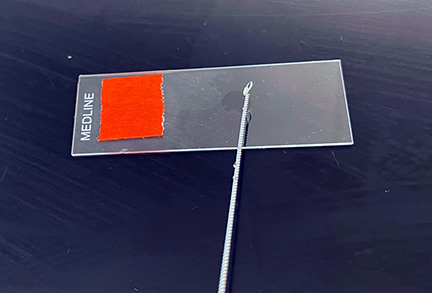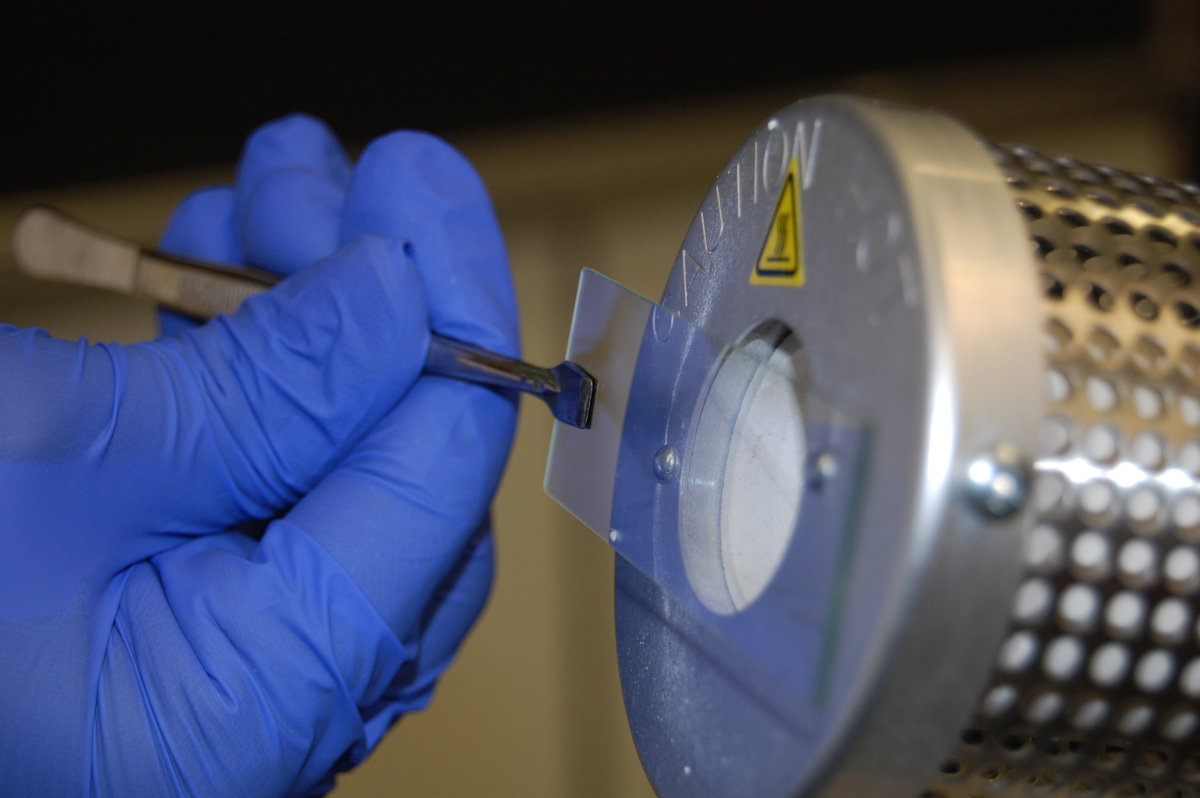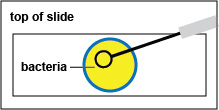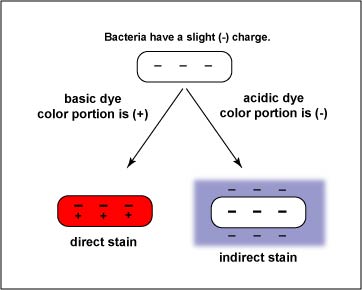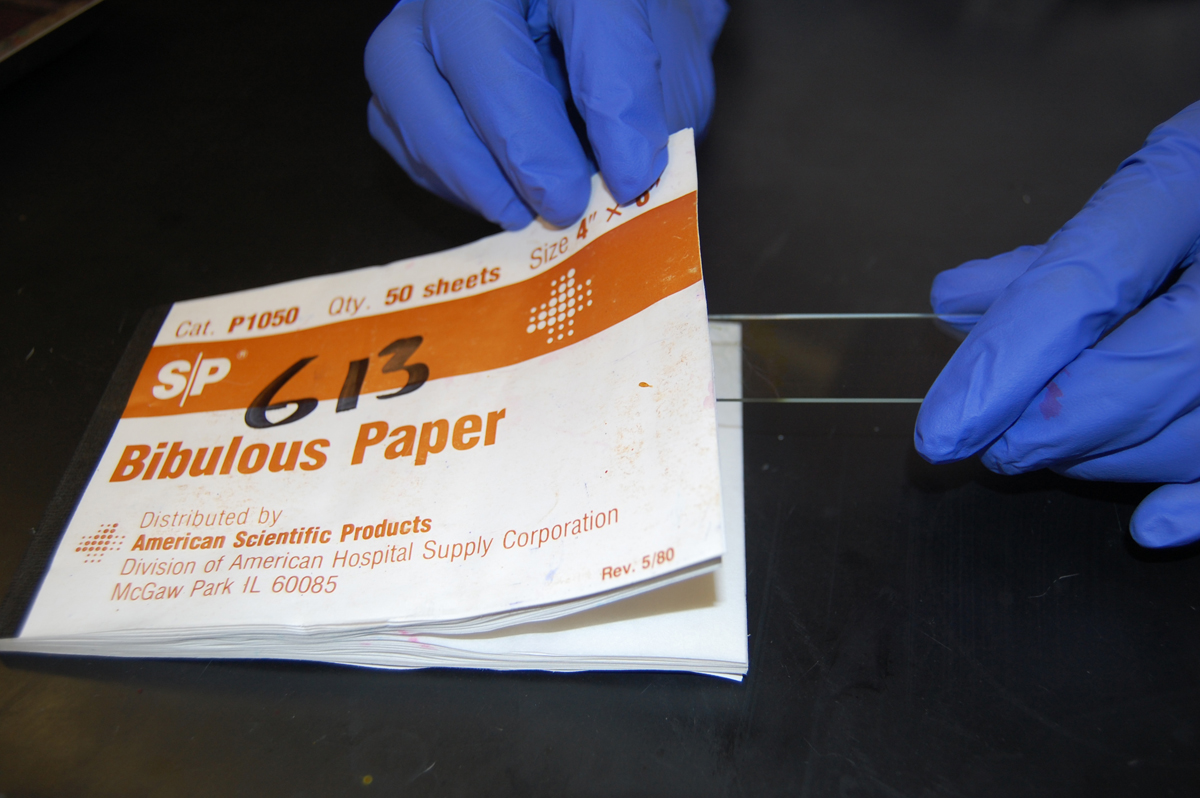A. INTRODUCTION TO STAINING
DISCUSSION
In our laboratory, bacterial morphology (form and structure) may be examined in two ways:
- by observing living unstained
organisms (wet mount), or
- by observing killed stained
organisms.
- see greater contrast between
the organism and the background,
- differentiate various morphological
types (by shape, arrangement, Gram reaction, etc.),
- observe certain structures
(flagella, capsules, endospores, etc.).
Before staining bacteria, you must first understand how to "fix" the organisms to the glass slide. If the preparation is not fixed, the organisms will be washed off the slide during staining. There are two common techniques for doing this: heat fixation and chemical fixation.
| Video review - How to Heat-Fix a Microscope Slide |
| Video review - How to Chemically Fix a Microscope Slide with Methanol |
1. Heat fixation
The bacteria are heat fixed by holding the bottom of the slide against the opening of a microincinerator for 10 seconds. The heat coagulates the organisms' proteins causing the bacteria to stick to the slide.
2. Chemical fixation
An air-dried smear of the organism is covered with several drops of 95% methanol and allowed to sit for 2 minutes, after which the methanol is poured off and the slide is again allowed to air dry. Chemical fixation has been shown to be better at enabling bacteria to adhere to the slide while causing less damage and distortion to the bacteria.
The procedure for slide preparation prior to staining is as follows:
1. If the culture is taken from an agar medium:
a. First place a small piece of tape at one end of the slide and label it with the name of the bacterium you will be placing on that slide .
b. Sterilize your inoculating loop and place one loop full of deionized water from your dropper bottle on your slide. (See Fig. 1, Step 1, Fig. 1, Step 2, and Fig. 1, Step 3.
Fig. 1, Step 1: Remove a Loopfull of Deionized Water
Fig. 1, Step 2: Place the Loopfull of Water on the Slide
Fig. 1, Step3: Correct Amount of Water on the Slide
Using your sterilized inoculating loop, remove one loopfull of water from your bottle of deionized water.
Place the loopfull of water on your slide.
A loopfull of deionized water on your slide.Gary E. Kaiser, Ph.D.
Professor of Microbiology
The Community College of Baltimore County, Catonsville Campus
This work is licensed under a Creative Commons Attribution 3.0 Unported License
Gary E. Kaiser, Ph.D.
Professor of Microbiology
The Community College of Baltimore County, Catonsville Campus
This work is licensed under a Creative Commons Attribution 3.0 Unported License
Gary E. Kaiser, Ph.D.
Professor of Microbiology
The Community College of Baltimore County, Catonsville Campus
This work is licensed under a Creative Commons Attribution 3.0 Unported License
c. Using the edge of your sterile inoculating loop, aseptically remove a small amount of the culture from the agar surface (see Fig. 2, Step 1) and gently touch it several times to the drop of water until the water becomes visibly cloudy. (See Fig. 2, Step 2 and Fig. 2, Step 3.)
Fig. 2, Step 1: Using the Edge of the Loop, Remove Bacteria from the Petri Plate
Fig. 2 , Step 2: Add Small Amount of Bacteria to the Water
Fig. 2 ,Step 3: Correct Amount of Bacteria Added to the Water
Using the edge of your sterilized inoculating loop, remove a small amount of bacteria from the petri plate.
Repeatedly touch the edge of the inoculating loop until the water just turns cloudy. Be carefull not to add too much bacteria.
This is the correct amount of bacteria to add to the water for a good bacterial smear.Gary E. Kaiser, Ph.D.
Professor of Microbiology
The Community College of Baltimore County, Catonsville Campus
This work is licensed under a Creative Commons Attribution 3.0 Unported License
Gary E. Kaiser, Ph.D.
Professor of Microbiology
The Community College of Baltimore County, Catonsville Campus
This work is licensed under a Creative Commons Attribution 3.0 Unported License
Gary E. Kaiser, Ph.D.
Professor of Microbiology
The Community College of Baltimore County, Catonsville Campus
This work is licensed under a Creative Commons Attribution 3.0 Unported License
d. Incinerate the remaining bacteria on the inoculating loop. If too much culture is added to the water, you will not see stained individual bacteria.
e. After the inoculating loop cools, spread the suspension over the slide to form a thin film. (See Fig. 3.)
Fig. 3: Spread the Mixture over the Slide
Using the loop, spread the mixture over the entire slide to form a thin film.Gary E. Kaiser, Ph.D.
Professor of Microbiology
The Community College of Baltimore County, Catonsville Campus
This work is licensed under a Creative Commons Attribution 3.0 Unported License
f. Allow this thin suspension to completely air dry. (See Fig. 4.) The smear must be completely dry before the slide is fixed!
Fig. 4: Let Slide Air Dry
Allow this thin suspension to completely air dry. A thin, powdery film should appear on the slide.Gary E. Kaiser, Ph.D.
Professor of Microbiology
The Community College of Baltimore County, Catonsville Campus
This work is licensed under a Creative Commons Attribution 3.0 Unported License
g. If your professor instructs you to heat-fix the bacteria to the slide, pick up the air-dried slide with provided close pin and hold the bottom of the slide opposite the smear against the opening of the bacto-incinerator for 10 seconds. as demonstrated by your instructor. (See Fig. 5.) If the slide is not heated enough, the bacteria will be washed off the slide. If it is overheated, the bacteria structural integrity can be damaged.
Fig. 5: Heat Fixing a Slide
To heat-fix the bacteria to the slide, pick up the air-dried slide with coverslip forceps and hold the bottom of the slide opposite the smear near the opening of the bcto-incinerator for 10 seconds.Gary E. Kaiser, Ph.D.
Professor of Microbiology
The Community College of Baltimore County, Catonsville Campus
This work is licensed under a Creative Commons Attribution 3.0 Unported License
h. If your professor instructs you to fix the bacteria to the slide using methanol, add 2-3 drops of 95% methanol to the air-dried smear of bacteria (see Fig. 6) and let sit for 2 minutes or until the methanol evaporates. Let the slide again air dry before staining.
Fig. 6: Add 2-3 Drop of Methanol to "Fix" the Smear
Using a disposable pipette, add 2-3 drops of 95% methanol to the bacterial smear. Let sit for 2 minutes or until the methanol evaporates. Allow to completely air dry. A thin, powdery film should appear on the slide.Gary E. Kaiser, Ph.D.
Professor of Microbiology
The Community College of Baltimore County, Catonsville Campus
This work is licensed under a Creative Commons Attribution 3.0 Unported License
2. If the organism is taken from a broth culture:
a. First place a small piece of tape at one end of the slide and label it with the name of the bacterium you will be placing on that slide.
b. Using a sharpie, draw a circle about the size if a nickel on the bottom of your microscope slide. (See Fig. 7, step 1.)
Fig. 7, Step 1: Draw a Circle on the Bottom of the Slide
Using a sharpie, draw a circle about the size if a nickel on the bottom of your microscope slide.Gary E. Kaiser, Ph.D.
Professor of Microbiology
The Community College of Baltimore County, Catonsville Campus
This work is licensed under a Creative Commons Attribution 3.0 Unported License
c. Turn the slide over. Using your sterile inoculating loop, aseptically place 1 - 2 loops of the culture within this circle on the top of the slide (see Fig. 7, step 2.) Do not use water.
Fig. 7, Step 2: Place 2 or 3 Loops of the Culture Within this Circle on the Top of the Slide
Turn the slide over. Using your sterile inoculating loop, aseptically place 2 or 3 loops of the culture within this circle on the top of the slide. Do not use water.Gary E. Kaiser, Ph.D.
Professor of Microbiology
The Community College of Baltimore County, Catonsville Campus
This work is licensed under a Creative Commons Attribution 3.0 Unported License
d. Using the inoculating loop, spread the suspension over the area delineated by the circle to form a thin film.
e. Allow this thin suspension to completely air dry.
f. If your professor instructs you to heat-fix the bacteria to the slide, pick up the air-dried slide with provided close pin and hold the bottom of the slide opposite the smear against the opening of the bacto-incinerator for 10 seconds. (See Fig. 5 above.) If the slide is not heated enough, the bacteria will be washed off the slide. If it is overheated, the bacteria structural integrity can be damaged.
g. If your professor instructs you to fix the bacteria to the slide using methanol, add several drops of 95% methanol to the air-dried smear of bacteria (see Fig. 6, above) and let sit for 2 minutes. Pick up the slide and allow the excess methanol to drain off. Let the slide again air dry before staining.
In order to understand how staining works, it will be helpful to know a little about the physical and chemical nature of stains. Stains are generally salts in which one of the ions is colored. (A salt is a compound composed of a positively charged ion and a negatively charged ion.) For example, the dye methylene blue is actually the salt methylene blue chloride which will dissociate in water into a positively charged methylene blue ion which is blue in color and a negatively charged chloride ion which is colorless.
Dyes or stains may be divided into two groups: basic and acidic. If the color portion of the dye resides in the positive ion, as in the above case, it is called a basic dye (examples: methylene blue, crystal violet, safranin). If the color portion is in the negatively charged ion, it is called an acidic dye (examples: nigrosin, congo red).
Because of its chemical nature, the cytoplasm of all bacterial cells has a slight negative charge when growing in a medium of near neutral pH. Therefore, when using a basic dye, the positively charged color portion of the stain combines with the negatively charged bacterial cytoplasm (opposite charges attract) and the organism becomes directly stained (See Fig. 8.) An acidic dye, due to its chemical nature, reacts differently. Since the color portion of the dye is on the negative ion, it will not readily combine with the negatively charged bacterial cytoplasm (like charges repel). Instead, it forms a deposit around the organism, leaving the organism itself colorless. (see Fig. 8.) Since the organism is seen indirectly, this type of staining is called indirect or negative, and is used to get a more accurate view of bacterial size, shapes, and arrangements.
Fig. 8: Direct Staining and Indirect Staining
Gary E. Kaiser, Ph.D.
Professor of Microbiology
The Community College of Baltimore County, Catonsville Campus
This work is licensed under a Creative Commons Attribution 3.0 Unported License
In today's lab, we will make both direct and indirect stains of several microorganisms.
B. DIRECT STAIN USING A BASIC DYE
In direct staining the positively charged color portion of the basic dye combines with the negatively charged bacterium and the organism becomes directly stained.
| How to Heat-Fix a Microscope Slide |
| How to Prepare a Slide for Staining when using Bacteria from an Agar Culture |
ORGANISMS
Your pure cultures from Lab 3 of Staphylococcus epidermidis (coccus with staphylococcus arrangement) or Micrococcus luteus (coccus with a tetrad or a sarcina arrangement), and Escherichia coli (small bacillus), Pseudomonas aeruginosa (small bacillus), or Klebsiella aerogenes - formerly known as Enterobacter aerogenes (small bacillus).
PROCEDURE (to be done individually)
1. Escherichia coli, Pseudomonas aeruginosa, or Klebsiella aerogenes (formerly known as Enterobacter aerogenes).
a. Fix a smear of either Escherichia coli, Pseudomonas aeruginosa, or Klebsiella aerogenes to the slide as follows:
1. First place a small piece of tape at one end of the slide and label it with the name of the bacterium you will be placing on that slide .
2. Sterilize your inoculating loop and place one loop full of deionized water from your dropper bottle on your slide, as shown in Fig. 1, Step 1; Fig. 1, Step 2; and Fig. 1, Step 3 above.
3. Using the edge of your sterile inoculating loop, aseptically remove a small amount of the culture from the agar surface, as shown in Fig. 2, Step 1 above, and gently touch it several times to the drop of water until the water becomes visibly cloudy, as shown in Fig. 2, Step 2 and Fig. 2, Step 3 above.
4. Incinerate the remaining bacteria on the inoculating loop. If too much culture is added to the water, you will not see stained individual bacteria.
5. After the inoculating loop cools, spread the suspension over the slide to form a thin film, as shown in Fig. 3 above.
6. Allow this thin suspension to completely air dry, as shown in Fig. 4 above.. The smear must be completely dry before the slide is fixed!
7. If your professor instructs you to heat-fix the bacteria to the slide, pick up the air-dried slide with provided close pin and hold the bottom of the slide opposite the smear against the opening of the bacto-incinerator for 10 seconds, as shown in Fig. 5 above. If the slide is not heated enough, the bacteria will be washed off the slide. If it is overheated, the bacteria structural integrity can be damaged.
8. If your professor instructs you to fix the bacteria to the slide using methanol, add 2-3 drops of 95% methanol to the air-dried smear of bacteria, as shown in Fig. 6 above and let sit for 2 minutes or until the methanol evaporates. Let the slide again air dry before staining.
b. Place the slide on a staining tray and cover the entire film with safranin. (See Fig. 9A.) Stain for one minute.
Fig. 9A: Staining the Bacterial Smear
Add enough dye to cover the heat-fixed bacterial smear. Gary E. Kaiser, Ph.D.
Professor of Microbiology
The Community College of Baltimore County, Catonsville Campus
This work is licensed under a Creative Commons Attribution 3.0 Unported License
c. Pick up the slide by one end and hold it at an angle over the staining tray. Using the wash bottle on the bench top, gently wash off the excess safranin from the slide. (See Fig. 9B.) Also wash off any stain that got on the bottom of the slide as well.
Fig. 9B: Washing with Water
Use your water bottle to gently wash off the excess stain. Shake off the excess water but do not blot dry between steps.Gary E. Kaiser, Ph.D.
Professor of Microbiology
The Community College of Baltimore County, Catonsville Campus
This work is licensed under a Creative Commons Attribution 3.0 Unported License
d. Use a book of blotting paper to blot the slide dry. (See Fig. 10.) Observe using oil immersion microscopy.
Fig. 10: Blotting the Slide Dry
Use a book of blotting paper to blot the slide dry.Gary E. Kaiser, Ph.D.
Professor of Microbiology
The Community College of Baltimore County, Catonsville Campus
This work is licensed under a Creative Commons Attribution 3.0 Unported License
2. Micrococcus luteus or Staphylococcus epidermidis.
a. Fix a smear of either Micrococcus luteus or Staphylococcus epidermidis to the slide as follows:
1. First place a small piece of tape at one end of the slide and label it with the name of the bacterium you will be placing on that slide .
2. Sterilize your inoculating loop and place one loop full of deionized water from your dropper bottle on your slide, as shown in Fig. 1, Step 1; Fig. 1, Step 2, and Fig. 1, Step 3 above.
3. Using the edge of your sterile inoculating loop, aseptically remove a small amount of the culture from the agar surface, as shown in Fig. 2, Step 1 above, and gently touch it several times to the drop of water until the water becomes visibly cloudy, as shown in Fig. 2, Step 2 and Fig. 2, Step 3 above.
4. Incinerate the remaining bacteria on the inoculating loop. If too much culture is added to the water, you will not see stained individual bacteria.
5. After the inoculating loop cools, spread the suspension over the slide to form a thin film, as shown in Fig. 3 above.
6. Allow this thin suspension to completely air dry, as shown in Fig. 4. The smear must be completely dry before the slide is fixed!
7. If your professor instructs you to heat-fix the bacteria to the slide, pick up the air-dried slide with provided close pin and hold the bottom of the slide opposite the smear against the opening of the bacto-incinerator for 10 seconds, as shown in Fig. 5 above. If the slide is not heated enough, the bacteria will be washed off the slide. If it is overheated, the bacteria structural integrity can be damaged.
8. If your professor instructs you to fix the bacteria to the slide using methanol, add 2-3 drops of 95% methanol to the air-dried smear of bacteria, as shown in Fig. 6 above and let sit for 2 minutes or until the methanol evaporates. Let the slide again air dry before staining.
b. Stain with crystal violet for one minute.
c. Wash off the excess crystal violet with water.
d. Blot dry and observe using oil immersion microscopy.
3. Prepare a third slide of the normal microbiota and cells of your mouth as follows:
a. Use a sterile cotton swab to vigorously scrape the inside of your mouth and gums.
b. Rub the swab over the slide (do not use water), air dry, and heat-fix.
c. Stain with crystal violet for 30 seconds.
d. Wash off the excess crystal violet with water.
e. Blot dry and observe. Find epithelial cells using your 10X objective, center them in the field, and switch to oil immersion to observe your normal microbiota bacteria on and around your epithelial cells.
4. Make sure you carefully pour the used dye in your staining tray into the designated drains located at the three lab benches and not down the sinks used for hand washing.
C. INDIRECT STAIN USING AN ACIDIC DYE In negative staining, the negatively charged color portion of the acidic dye is repelled by the negatively charged bacterial cell. Therefore, the background will be stained and the cell will remain colorless.
ORGANISM
Use the pure culture of Micrococcus luteus provided.
PROCEDURE (to be done individually)
Video lesson - How to Make an Indirect Stain of Bacteria
1. Place a small drop of nigrosin towards one end of a clean microscope slide.
2. Using your sterile inoculating loop, aseptically add a small amount of Micrococcus luteus to the dye and mix gently with the loop.
3. Using the edge of another slide, spread the mixture with varying pressure across the slide so that there are alternating light and dark areas. (See Fig. 11.) Make sure the dye is not too thick or you will not see the bacteria!
Fig. 11: Spreading Nigrosin for an Indirect Stain
Using the edge of another slide, spread the mixture with varying pressure across the slide so that there are alternating light and dark areas.Gary E. Kaiser, Ph.D.
Professor of Microbiology
The Community College of Baltimore County, Catonsville Campus
This work is licensed under a Creative Commons Attribution 3.0 Unported License
4. Let the slide air dry completely on the slide. Do not heat fix and do not wash off the dye.
5. Make sure you carefully pour the used dye in your staining tray down the designated drains located in the three lab benches and not down the sinks used for hand washing.
6. Observe using oil immersion microscopy. Find an area that has neither too much nor too little dye (an area that appears light purple where the light comes through the slide). If the dye is too thick, not enough light will pass through; if the dye is too thin, the background will be too light for sufficient contrast.
RESULTSMake drawings of your three direct stain preparations and your indirect stain preparation.
Direct stain of Escherichia coli, Pseudomonas aeruginosa, or Klebsiella aerogenes (formerly known as Enterobacter aerogenes)Shape =
Shape =
Arrangement =
Indirect stain of Micrococcus luteus
Shape =
Arrangement =
PERFORMANCE OBJECTIVES FOR LAB 5
After completing this lab, the student will be able to perform the following objectives:
A. INTRODUCTION TO STAINING
1. Describe the procedure for heat fixation and methanol fixation.
2. Define the following: acidic dye, basic dye, direct stain, and indirect stain.
3. State in chemical and physical terms the principle behind direct staining and the principle behind indirect staining.
B. DIRECT STAINING
PROCEDURE
1. Transfer a small number of bacteria from an agar surface or a broth culture to a glass slide and fix the preparation to the slide.
2. Prepare a direct stain when given all the necessary materials.
RESULTS
1. Recognize a direct stain preparation when it is observed through a microscope and state the shape and arrangement of the organism.
C. INDIRECT STAINING
PROCEDURE
1. Perform an indirect stain when given all the necessary materials.
2. State why the dye is not washed off when doing an indirect stain.
RESULTS
1. Recognize an indirect stain preparation when it is observed through a microscope and state the shape and arrangement of the organism.
SELF-QUIZ
Microbiology Laboratory Manual by Gary E. Kaiser, PhD, Professor of Microbiology
is licensed under a Creative Commons Attribution 4.0 International License.
Last updated: March, 2023
Please send comments and inquiries to Dr. Gary Kaiser





